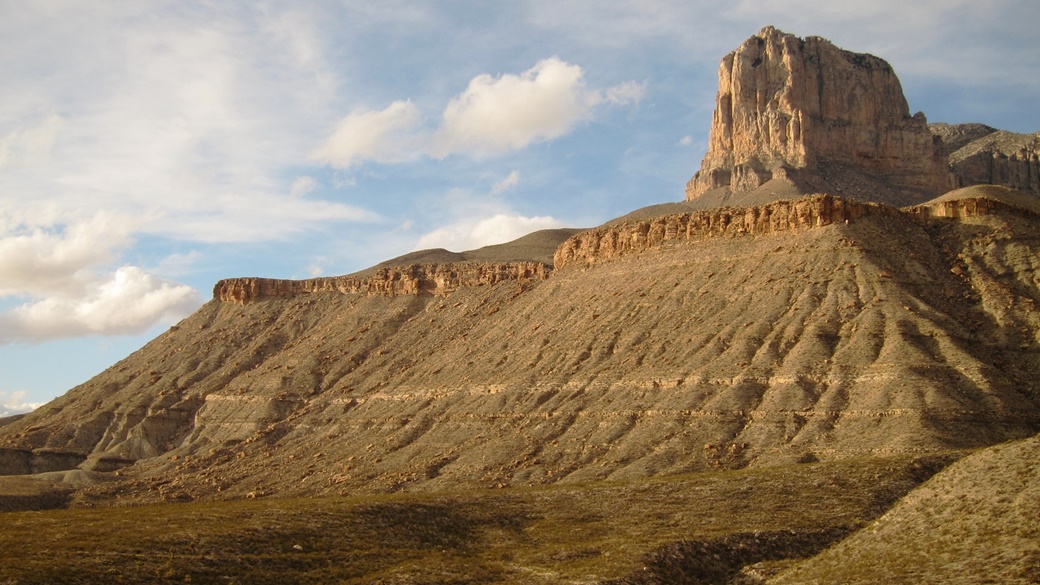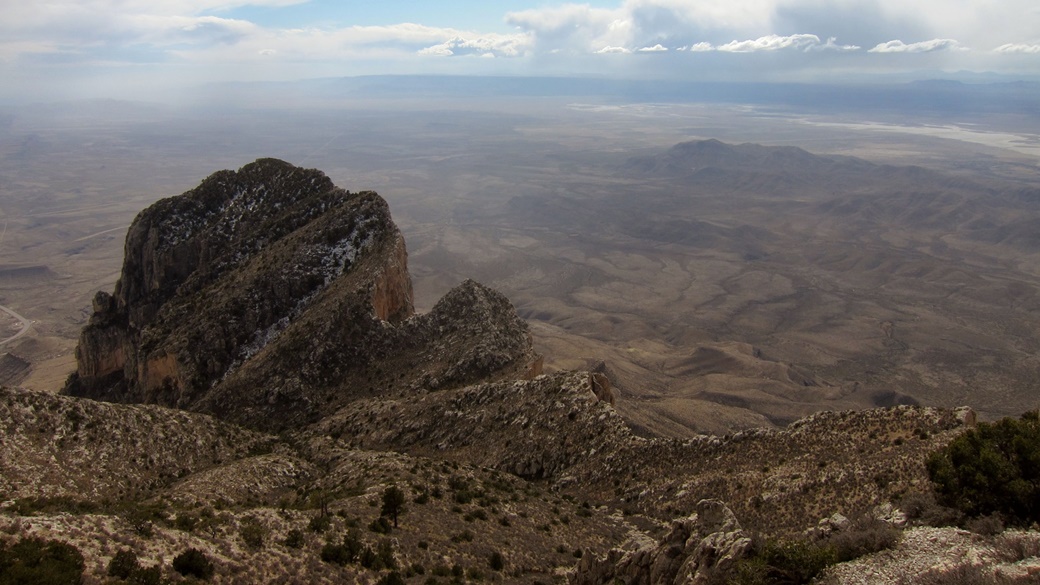Guadalupe Mountains National Park is situated in western Texas near the border with New Mexico and is also in close proximity to Carlsbad Caverns National Park. The park encompasses the Guadalupe Mountain range, which includes Guadalupe Peak, the highest mountain in Texas. The park’s primary purpose is to protect the preserved sandstone fossil formations from the Permian (Protohistoric) period.

Table of Contents
- Information About Guadalupe Mountains National Park
- What to See and Do in Guadalupe Mountains National Park
- When to Go to Guadalupe Mountains National Park
- Entrance Fees for Guadalupe Mountains National Park
- Transportation to Guadalupe Mountains National Park
- Lodging Options in Guadalupe Mountains National Park
- Tips and Recommendations Before Traveling to Guadalupe Mountains National Park
- Photos of Guadalupe Mountains National Park
Information About Guadalupe Mountains National Park
The Guadalupe Mountains are exceptional. Amid an arid, cactus-filled desert, the mountain range is dominated by 8,750 ft Guadalupe Peak, the highest mountain in Texas. Also notable is the 8,064 ft El Capitan formation, which shares its name with the more famous counterpart in Yosemite National Park. The El Capitan in Texas once served as a significant landmark on the Butterfield Overland Mail route from San Francisco to the eastern USA.
The caves around the national park hosted human life more than 10,000 years ago, and Europeans reached the area in the 16th century, but no major settlement attempts were made. It was only when the Mescalero Indians established settlements in the mountains and cultivated agave that people began to stay here, remaining until the 19th century. In 1858, an essential mail route crossed the park, and the Indians, who frequently attacked the mail convoys, were violently subdued. The ruins of the significant Pinery Station post office can still be seen about 1 mi north of the visitor center.
Guadalupe Mountains National Park was established on September 30, 1972. Much of the park’s land was donated by Humble Oil employee Wallace Pratt, who purchased the land in the 1920s. The national park spans only 135 sqmi, with a visitation of 243,291 in 2021.
The park houses about 60 species of mammals, 289 species of birds, and 55 species of reptiles. Sightings of the desert animals are rare, as they are primarily nocturnal. This includes coyotes, foxes, cougars, bobcats, badgers, lizards, and the 16 species of bats. However, early in the morning or in the evening, lucky visitors may spot deer, wild peccary pigs, or wild hares. Among the park’s venomous animals, the western rattlesnake resides in the park.
The plant kingdom is even more diverse in the Guadalupe Mountains. Over 1,000 species grow here, far beyond just typical desert plants like prickly pear cacti. The agave and yucca plants are interesting, capable of growing 10 cm in a single night. This growth spurt protects them from predators eager for tasty plant tops.
What to See and Do in Guadalupe Mountains National Park
Several attractions await you in Guadalupe Mountains National Park, all accessible by car:
El Capitan
At 8,064 ft, the eighth-largest peak in Texas is easily recognizable by its shape. So large, it has served as an important landmark for centuries. It is highly visible from Highway 62/180 west of the visitor center.
Dog Canyon
Dog Canyon is located in a remote area in the northern part of the park and is accessible via State Highway 137. The canyon’s surroundings directly invite exploration on foot or horseback. For example, take the 4 mi hike to the Marcus Overlook.
McKittrick Canyon
The canyon is especially worth a visit in October and November when the trees turn red, creating a beautiful contrast with the surrounding desert. The canyon can be reached via USA 62/180. Please note: The site is only accessible from 8:00 am to 6:00 pm (only until 4:30 pm from November to March).
Williams Ranch
Another park attraction is a 1908 ranch built in the middle of nowhere. It offers a beautiful view of the surrounding area and is accessed by an unpaved road that only high-slung, 4×4-powered vehicles can navigate.
Frijole Ranch
The Frijole Ranch and Cultural Museum is located in an oasis in the middle of the desert about 1 mi northeast of the visitor center. Normal hours of operation are 8:00 am to 4:30 pm. From the site, you can hike the 2 mi Smith Spring Trail.
Salt Basin Dunes
The bright white sand dunes are very remote even by local standards. Visitors can drive 50 mi one way to reach them, and are limited to a maximum speed limit of 25 mph.
Hikers have 80 mi of trails, noteworthy is the 8 mi (round-trip) Guadalupe Peak Trail stretching to the park’s highest mountain. Allow 6-8 hours to complete it, with a total elevation gain of a respectable 2,907 ft. It starts from the Pine Springs Trailhead near the visitor center of the same name.
Some of the trails are also open to horseback riders. Riding off the marked trails is prohibited.
When to Go to Guadalupe Mountains National Park
Guadalupe Mountains Park is accessible year-round, but the best time to visit is spring and fall when the plants are ablaze with color.
Spring temperatures usually hover around 50 °F at night and 75 °F during the day, with a similar pattern in autumn when higher rainfall can be expected. The rainiest months are August and July, which is also the hottest time of year. Daytime temperatures can exceed 90 °F.
In winter, temperatures usually do not drop below freezing, but strong winds of over 68 mph can spoil the weather. When visiting the park, keep in mind that the higher elevations are about 41 °F cooler than the lowlands.
Average Temperatures and Visitor Numbers in Guadalupe Mountains National Park
Average temperatures in Guadalupe Mountains at the Pine Springs location. Visitor counts are based on a 2017-2021 average, data source is the National Park Service.
| Max Temp | Min Temp | Precipitation Days | Visitors | Popularity | |
|---|---|---|---|---|---|
| January | 55 °F | 34 °F | 2.0 | 8 756 | 🟩 |
| February | 59 °F | 36 °F | 1.8 | 13 579 | 🟨🟨 |
| March | 64 °F | 41 °F | 1.7 | 29 228 | 🟧🟧🟧 |
| April | 73 °F | 48 °F | 1.9 | 20 366 | 🟧🟧🟧 |
| May | 82 °F | 55 °F | 3.8 | 19 964 | 🟨🟨 |
| June | 88 °F | 63 °F | 5.7 | 14 792 | 🟨🟨 |
| July | 88 °F | 64 °F | 8.0 | 13 532 | 🟨🟨 |
| August | 86 °F | 63 °F | 8.6 | 13 126 | 🟨🟨 |
| September | 81 °F | 57 °F | 7.1 | 12 684 | 🟨🟨 |
| October | 73 °F | 50 °F | 4.2 | 20 946 | 🟧🟧🟧 |
| November | 63 °F | 41 °F | 2.3 | 20 316 | 🟧🟧🟧 |
| December | 55 °F | 34 °F | 2.4 | 15 025 | 🟨🟨 |
Entrance Fees for Guadalupe Mountains National Park
The entrance fee to Guadalupe Mountains National Park is $10.00 per person over the age of 16. This fee is valid for 7 days and can be paid by credit card at the visitor center.
If you plan to visit more than one national park during your trip to the USA, I recommend the America the Beautiful pass. With this pass in your pocket, you can visit all National Parks without restrictions for one year after purchase. Annual pass costs $80.
Transportation to Guadalupe Mountains National Park
There are no buses or other forms of public transportation to Guadalupe Mountains National Park. You will have to rely on your own or a rental car. A 4×4 off-road vehicle can be very useful for traversing some of the roads.
The park is easily accessible via USA 62, which runs west to El Paso and northeast to Carlsbad. For your convenience, below are routes and commute times from several nearby towns:
| Location | Distance | Drive Time | Route |
|---|---|---|---|
| Albuquerque | 328 mi | 5 hours 15 minutes | View Route |
| Dallas | 512 mi | 7 hours 50 minutes | View Route |
| El Paso | 111 mi | 2 hours | View Route |
A car is also needed while traveling around the park as there are no buses or vans. The roads are unpaved and parking is available along them or at the visitor center.
Lodging Options in Guadalupe Mountains National Park
🏨 Hotels
There are no hotels or motels directly in the park. I recommend driving to Carlsbad or El Paso. Both cities offer budget motel chains like Super 8 and Motel 6.
⛺ Campsites
You can also choose to stay overnight at one of the two campsites belonging to the park. In both, you pay $20.00 for a tent site per night.
- Pine Springs Campground
Located at the base of the mountain near the Pine Springs Visitor Center at an elevation of 5,823 ft, the campground has a drinking water source, restrooms, and 20 tent sites with picnic tables; showers are not available. - Dog Canyon Campground
This small campground with only 9 tent sites and 4 RV sites is located at an elevation of 6,280 ft. Showers are not available here either.
Tips and Recommendations Before Traveling to Guadalupe Mountains National Park
ℹ️ Visitor Center
When traveling to Guadalupe Mountains National Park, I recommend visiting the Pine Springs Visitor Center first. It’s located in the village of the same name near USA 62/180. Open every day except Christmas Eve from 8:00 am to 4:30 pm, you can buy souvenirs, gather information, or get your passport stamped at the center.
👍 Good to Know
Food is not available for purchase within the park, so be sure to buy snacks and water in Whites City, Carlsbad, El Paso, or any other city you’ll be passing through. I also recommend packing an extra layer of clothing in your backpack in case of a sudden drop in temperature.
Photos of Guadalupe Mountains National Park







US National Parks
- National Parks of the USA – Map, List and Annual Pass
- America the Beautiful Pass 2025 – How It Works, Cost & Parks
- Timed-Entry Reservation for US National Parks (2025 GUIDE)
Travel Guides to USA National Parks

 10 Best Photo Places in the USA
10 Best Photo Places in the USA




Contribute with Your Question or Personal Experience